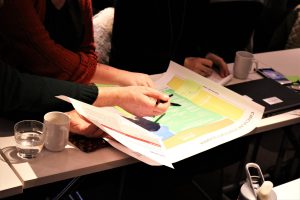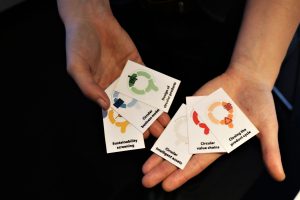


Increasing competitiveness and contributing to sustainability are just two of the reasons why interest in circular economy is growing worldwide. To help manufacturing companies transition to a more circular economy, the CIRCit project is developing a set of tools and approaches to align business processes with closing resource loops and creating value at the same time. During the 2018-2019 winter workshop series companies from all over the Nordic region got the first taster of these tools and approaches.
In a linear economy, materials are extracted, turned into products and disposed of after a relatively short use phase. In a circular economy, on the other hand, more use is made of materials and products, whilst benefits for the economy, society and the environment are created. This has the potential to create sustainability benefits and to contribute to the UN’s Sustainable Development Goal number 12 “Responsible Production and Consumption.”
Approaches and tools to use for circular economy in workshops
To enable transition to a more circular economy many questions need to be answered. For example: when is a circular solution more sustainable? But also: how can value be reclaimed from used goods, components and materials? And how can business models, the design of products, digital technologies and collaborations support companies in operating in line with circular economy principles? Answering these questions gives insight into which business processes need to undergo innovation.
What approaches and tools to use for circular economy driven innovation was the theme of five workshops offered in Finland, Iceland, Sweden, Norway and Denmark. With close to 100 participants, many companies and other interested organisations learned about the experience of companies who have already taken steps towards greater circularity.
Voices in the workshop
Peter Larsson, one of the owners of the coffee machine company 3TEMP / PLAE2TECH, which provide high-end coffee machines mainly for cafes selling special coffees, described what they learned and what they gained from cooperating with the project. They are a co-creation partner in the CIRCit project, which means they are a company where the CIRCit- tools are further developed. Peter Larsson presented how they have been helped by CIRCit to develop methods and tools that suits them what insights were gained from it, and how it has influenced their circular economy journey. Through understanding their product design process and what circular business models are suitable for their product, the company has restructured their offering, now including leasing and support services that enable remote support and provide their customers more insight into their operations.
-Now we are heading towards and developing a web tool that helps the customer to choose the right coffee machine equipment adapted and optimized for the customer’s daily needs, that is, a product configurator, a guide tool. Through this, we go from a classic sale of a machine to selling a service, which in this case means that the café pays per cup of coffee they sell. The customer receives direct control with connected machine on daily costs, income, service and coffee purchases. This is partly due to the dynamic process and the cooperation we have with the project CIRCit. Our idea image is different when we process with the project and new approaches provide new conditions for a more powerful guide tool. It is built of different technical flows that are put together and leads to a stronger circular economy for us. Furthermore, we have had an internal brainstorming with individuals in the company who possess different competencies such as process technicians, designers, programmers, marketers, sellers and others in the company, which led to solutions that are good both technically, but also for our business and sustainability. It is also a great advantage to meet other companies and networks to exchange experiences, says Peter Larsson.
In addition to companies such as 3TEMP/ PLAE2TECH, but also Konecranes, Össur, Ope and Vestre sharing insights, try-outs were provided of the tools for developing Circular business models, Design of circular products, Circular intelligent assets, Closing the product cycle, Circular value chains and Sustainability screening.
-I have read a lot about circular economics and have an educational background in environment, innovation and sustainability but have lacked the practical tools how to accurately translate this into changing business models and finding partnerships. This workshop has made me more prepared to actually find solutions in the business world. As a consultant, I think I have received many good tips and tricks for identifying problems and solution suggestions at customers, says Viktoria Sandström, management consultant in the field of innovation and production at the consulting company Ekan Management.
Validation phase
In the next phase of the CIRCit project the tools and approaches will be further developed, together with both the co-creation companies, who receive active support from CIRCit researchers and with validation partners, who receive early access to the tools in exchange for feedback on their usability.
Anna Karin Jönbrink from the Swedish CIRCit team adds:
-Note that, in the next step there is the possibility for companies to be involved as validation partners, which means that via webinars, for the different sub-areas, they are introduced to the different tools, and receive support in trying them in their own company. Subsequently, comments from the evaluating companies will be collected and used for further development of the tools. If you have an interest in participating in this next step, you are welcome to contact Fenna Blomsma fblo@mek.dtu.dk
Author: Helena Svensson
See the film CIRCit – Validation partners
